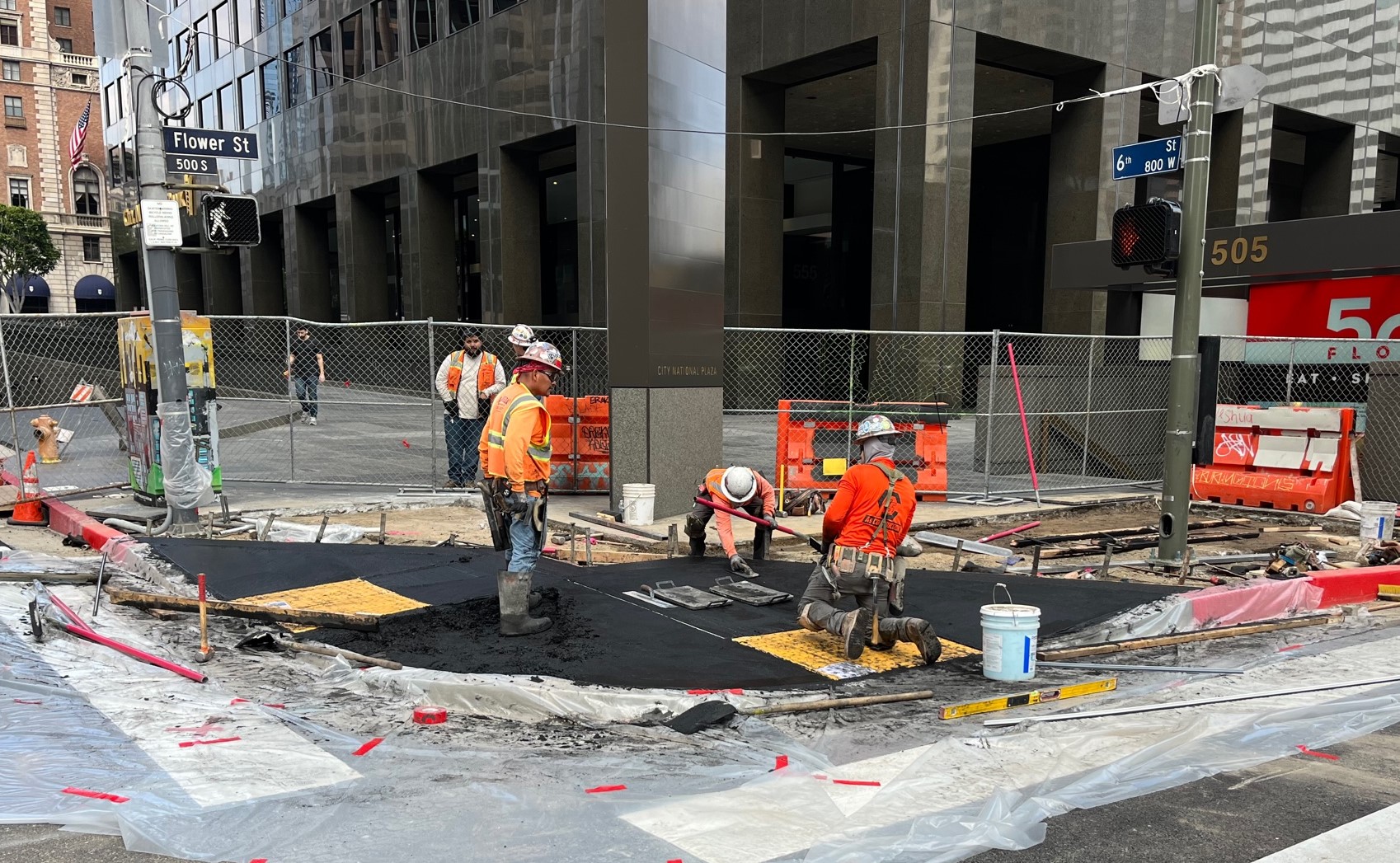Sidewalks are a huge part of the city's dubious cost estimates for Measure HLA currently before L.A. voters. This post explores how city sidewalk costs are increasing - to pay for long overdue accessibility improvements - but that the city is on the hook for all these sidewalk costs whether HLA passes or not.
In case you're unfamiliar with Measure HLA, the Healthy Streets L.A. initiative: it's a ballot measure that would require the city to gradually implement its own approved Mobility Plan. HLA would require the city to implement approved bus, bike, and walk improvements when the city repaves streets.
City Claim: HLA Would Cost $2 Billion for Sidewalks
On February 16, the City Administrative Officer (CAO) announced an estimate that HLA would cost $3.1 billion dollars over ten years. Don't take that inflated total too seriously - it's wrong - but let's look at what's in the CAO estimate.

It's mostly sidewalks.
Two-thirds of the CAO estimate is for sidewalks: $2 billion over 10 years.
Per the CAO, $200 million annually are included in Measure HLA costs for implementing the city Mobility Plan's pedestrian districts, where the city would be "required to ensure that all sidewalks are in good repair and ADA compliant."
That $200 million annually is about four times the $45.7 million that the city currently spends on these programs: (more on these below)
- Sidewalk repair: $35.7 million in the city's Safe Sidewalks program from the Willits Settlement
- ADA compliance: $10 million for curb ramps - part of the city's Pavement Preservation Program (PPP)
The CAO explained the city's assumptions: roughly 80 percent of 1,120 miles of pedestrian district sidewalks would need to be replaced at a cost of $2.25 million per mile of 9-foot wide sidewalk.
City Claim: New Federal Requirements
In the CAO HLA cost estimate discussion, Council President Paul Krekorian alluded to a recent change: "requirements of the new federal interpretations regarding ADA compliance when streets are repaved." CAO Matt Szabo and Bureau of Streets Services (StreetsLA) General Manager Keith Mozee both responded affirming "federal requirements" mandating ADA compliance accompany resurfacing.
"Any time we do street resurfacing, it is considered an alteration, which requires ADA ramps to be installed," Mozee said, noting the city is currently designing "approximately 1,200 access ramps" to installed as part of next year's "normal resurfacing program."
"When we are conducting work and when there is work on the street, or when there is work on the sidewalk," Szabo said, "we are required to ensure that the entirety of the sidewalk is ADA compliant."
If true, this represents a significant change in how the city works.
Historically through today, street repaving and sidewalk work were and are two largely unconnected city programs.
StreetsLA's massive Pavement Preservation Program (PPP) - "the largest municipal Street Preservation Program in the nation," per StreetsLA - has long prioritized smooth pavement for drivers, not sidewalks for people getting around on foot and by wheelchair. From 2016 through 2021, the city's annual PPP budget included $3 million for curb ramps and more than $100 million for resurfacing.

In the past two fiscal years, the curb ramp budget grew somewhat - to $8 million then $11 million. The current year's budget has $20 million for access ramp work, compared to roadway work totaling ~$186 million ($154 million for PPP, plus $32 million for similar programs, including a tiny Complete Streets program that doesn't live up its name).
The city completes 20-40+ street resurfacing projects every month, while a growing backlog of ADA ramp projects continue to pile up.
But now, due to "new federal requirements" CAO Szabo says that "when there is work on the street," the city is "required to ensure that the entirety of the sidewalk is ADA compliant."
So what changed? When? What are those new federal requirements?
More than a week ago, Streetsblog L.A. asked StreetsLA to clarify what changed and what new requirements Mozee was referring to. To date, after repeated follow-up queries, the city's response is that they are working on a response.
What didn't change: when the city resurfaces, curb ramps are required
Jan Garrett of the Pacific ADA Center noted that cities have long been required to install curb ramps during street resurfacing. This is part of Title II of the ADA.

In 2013, the federal Departments of Justice (USDOJ) and Transportation (USDOT) made it clear that street resurfacing triggers curb ramp installation - via a joint technical assistance rule. The current version of the rule (dated 2018) reads:
Title II of the Americans with Disabilities Act (ADA) requires that state and local governments ensure that persons with disabilities have access to the pedestrian routes in the public right of way. An important part of this requirement is the obligation whenever streets, roadways, or highways are altered to provide curb ramps where street level pedestrian walkways cross curbs. [...]
An alteration is a change that affects or could affect the usability of all or part of a building or facility. Alterations of streets, roads, or highways include activities such as reconstruction, rehabilitation, resurfacing, widening, and projects of similar scale and effect. [...]
Because resurfacing of streets constitutes an alteration under the ADA, it triggers the obligation to provide curb ramps where pedestrian walkways intersect the resurfaced streets.
Department of Justice/Department of Transportation Joint Technical Assistance on the Title II of the Americans with Disabilities Act Requirements to Provide Curb Ramps when Streets, Roads, or Highways are Altered through Resurfacing
So, L.A. should have tied ADA work to resurfacing at least a half a dozen years ago. Arguably this should have been since the early 1990s when ADA went into effect.
Both Mozee and Szabo mentioned that the city is upping PPP access ramp work (whether HLA passes or not), likely to at least double the ramps budget from $20 million to around $60 million in the next fiscal year.

Increasing the city ADA ramp budget is great. L.A. City should have been doing this since 2013; better late than never.
What didn't change: Sidewalk Repair
Many Streetsblog readers know that in 2016, the city settled a lawsuit brought by accessibility advocates. In the Willits Settlement, the city committed to $1.4 billion worth of sidewalk repair over thirty years.

Under Willits, the city currently spends $35.7M each year on its Safe Sidewalks L.A. program. The city's sidewalk repair work has always been separate from PPP.

According to the CAO, the city has a massive backlog in sidewalk repair requests: $177.8 million per year.
Coming Soon: PROWAG
Back to: what changed? There is a new federal accessibility rule change in process. It's called "PROWAG" for Public Accessibility Right-of-Way Guidelines. PROWAG is in the works, but it hasn't taken effect yet.
In August 2023, the federal Access Board published its Accessibility Guidelines for Pedestrian Facilities in the Public Right-of-Way (PROWAG). These are expected to be adopted by USDOT and USDOJ at some point, but there's no timeline right now.
The new rule, once approved, would not change triggers for ADA work. PROWAG does note (referring back to the earlier 2013 federal directive) that resurfacing (an "alteration") does trigger ADA compliance, including curb ramps.
PROWAG clarifies what overall ADA compliance looks like. Yes - curb ramps, plus: accessible pedestrian circulation paths (including sidewalks in good repair), accessible signal timing, pedestrian pushbuttons, on-street parking for drivers with disabilities, curb ramp placement, and much more.
No one at the city will confirm this, but from Szabo, Mozee, and Krekorian's remarks, it appears that L.A. City is now acting as if PROWAG is already city policy. This is good news for folks with disabilities, folks who get around on foot, and even cyclists who take advantage of curb cuts and sidewalks (especially along streets with high volumes of cars and no provision for bikes).
L.A. taking PROWAG seriously will mean more city resources going to curb ramps, sidewalk repair, and many other ADA compliance features.
What Does All This Have to With Measure HLA? Very Little
So, right now L.A. City street resurfacing is apparently triggering ADA work - whether HLA passes or not.
If HLA passes, street resurfacing will trigger that very same ADA work, plus bus lanes and bike lanes.
The CAO is saying $200 million worth of annual ADA work is "included in the cost" of Measure HLA. But if right now the city is already on the hook for all that ADA work anyway, none of it should be included as HLA costs.
It appears that city leaders are making HLA into a scapegoat. The CAO is exaggerating estimates, pitting bus/bike against walk/wheelchair, all of which the city has neglected for decades. If HLA passes, city leaders can blame HLA (instead of decades of city neglect) for increased budgets for ADA compliance.
Measure HLA probably doesn't do enough for pedestrians and people with disabilities. When HLA qualified for the ballot two years ago, tying Mobility Plan pedestrian improvements to resurfacing mainly meant basic stuff: crosswalks, painted curb extensions, and the like. It's great that the city is stepping up its sidewalk work programs now, because the pedestrian improvements HLA envisioned were modest.
If it passes, HLA will mainly facilitate bus and bike lane projects, which have always been very inexpensive in material costs. The materials cost is basically paint (called "thermoplastic" essentially very durable paint) with minimal accompanying signage, bollards, etc. The primary barrier to bus and bike facility implementation has been the political - not the financial - cost of reallocating road space.
SBLA endorses a yes vote on Measure HLA. Voter turnout could be low, so get your ballot in early. Get involved in passing HLA via the Yes on HLA campaign website.







